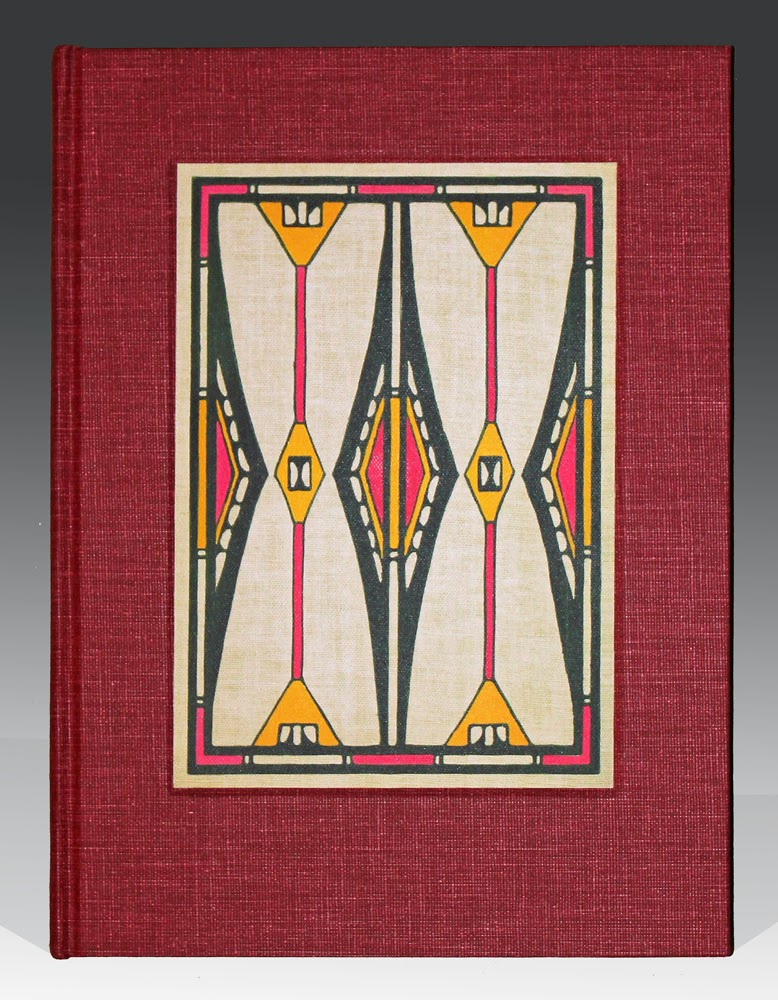The current exhibition of Native American themed bindings has 116 different designs and 25 variants. One of the great designs that was ahead of its time is Florence Lundborg's 1904 cover for Yosemite Legends by Bertha Smith. It shows the influence of Albert Pinkham Ryder, and of Whistler, at whose short-lived Paris art school she spent the winter of 1899-1900. She had previously studied in San Francisco with Arthur Mathews at the California School of Design. Mathews, who had studied architecture with his father before attending the Académie Julian in Paris, was a strong proponent of the Arts and Crafts aesthetic. Here the mists of Tonalism are gone, but the abstraction to simplified elements remains, with the totemic border rendered in Arts and Crafts style. Variant copies of the same edition are on green and russet buckram.
Florence Lundborg
Yosemite Legends by Bertha H. Smith
San Francisco: Paul Elder, 1904
Florence Lundborg
Yosemite Legends by Bertha H. Smith
San Francisco: Paul Elder, 1904
Margaret Armstrong often created variants of her bindings. For two titles by Washington Irving she made different covers with the same spine design, with variant cloth and stamping colors for each. The current exhibition includes this display of the four two-volume sets:
Margaret Armstrong
Astoria by Washington Irving
New York and London: G. P. Putnam's Sons, 1897, Tacoma Edition
and
The Adventures of Captain Bonneville U.S.A. by Washington Irving
New York and London: G. P. Putnam's Sons, 1898, Pawnee Edition
The cover of The Indians' Book, a volume of songs, stories, photos and artwork from many Indian tribes, collected and recorded by Natalie Curtis, was originally issued by Harper in 1907 in an unsigned binding. Most likely the cover was done by Angel de Cora (Hinook Mahiwi Kilinaka), a Winnebago from Nebraska born in 1871 who studied art at Smith College, illustration at Drexel, and at Boston's Cowles Art School. She did (and signed) the title page, and also did the lettering on the additional title pages that precede each section of the book.
A slightly revised edition was issued in 1923. This edition contains some additional drawings, photos and other material, but not all the additional songs that Natalie Curtis had planned to include in it. On October 23, 1921 she was hit by a car while crossing a street in Paris and died almost instantly. The cover uses the same design in a different color scheme.
Angel de Cora (Hinook Mahiwi Kilinaka)
The Indians' Book, Recorded and Edited by Natalie Curtis
New York and London: Harper and Brothers, 1907
Angel de Cora (Hinook Mahiwi Kilinaka)
The Indians' Book, Recorded and Edited by Natalie Curtis
New York and London: Harper and Brothers, n.d., ©1923
This copy with the publisher's printing code L-E (November, 1930)
The variant cover for the 1936 reprint of Blankets and Moccasins is particularly interesting because it uses an overprinting technique with semi-transparent inks to create additional colors. The first edition of 1933 includes a lengthy colophon, but only indicates that the cover design is from an Indian blanket.
Indian blanket design
Blankets and Moccasins by Gwendolin Damon Wagner and Dr. William A. Allen
Caldwell, Idaho: The Caxton Printers, Ltd., 1933, September
Indian blanket design
Blankets and Moccasins by Gwendolin Damon Wagner and Dr. William A. Allen
Caldwell, Idaho: The Caxton Printers, Ltd., 1936, December
Detail showing indigo, red, and overprinting
The enlarged detail below includes a black letter from the title. Using a less viscous, more transparent ink for the indigo would create this effect, with the ink flowing into the crevices more readily and being more transparent on the elevated parts of the weave. By using a kiss impression and greater viscosity for the red stamping, the fine texture of the cloth would be maintained and more of the red would stay high on the weave, allowing the indigo to run into the valleys. The black title is stamped with a slightly deeper impression than the blanket pattern, somewhat flattening the weave.
For more images of covers in this exhibition and information about the catalog, click here.























































